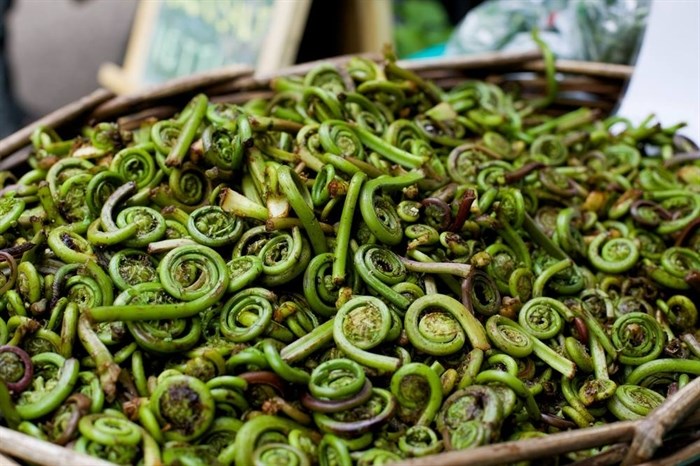
Fiddleheads, the furled fronds of young ferns, are available for a couple weeks every spring in the Thompson-Okanagan.
Image Credit: Shutterstock
May 13, 2015 - 4:32 PM
VERNON - You might have seen the bright, vibrantly green curlicues in classified ads or at the local grocery store recently and wondered what they are and where they come from. They’re called fiddleheads, and they’re found around the world, including the Thompson-Okanagan, for a few short weeks every spring.
Those who have tried the mystical-looking furled fronds of young ferns rave about the fresh, asparagus-like taste and tender texture. But be warned, while all ferns produce fiddleheads, many are considered poisonous.
Don Elzer is a wildcrafter at Lumby’s Wildcraft Forest and he says the type of fiddleheads that can be consumed in our area come from ostrich ferns. Grocery stores can import different fiddleheads from other countries, but the ones you’re seeing on shelves now are likely from around here, and that means they must be from ostrich ferns.
“If you’re going online or to the grocery store, ask if they’re from ostrich ferns. If someone says they’re not sure, don’t buy them,” Elzer cautions.
With a good plant book, ostrich ferns are fairly easy to identify, but that being said, there are many varieties of ferns and picking the wrong one can have unfavourable results, Elzer says. Care must also be taken in preparing the fiddleheads for consumption to ensure they are tasty, not toxic.
“Some people will think they’re fresh and wonderful and want to put them in salads — don’t do that,” Elzer says. “They can lead to food poisoning if eaten raw and should always be cooked.”
Fiddleheads are good thrown into soups, stir-fries, and many other dishes, but should be well-rinsed and cooked for about 15 minutes beforehand, and must always have their paper-like husks removed, Elzer says.
In the wild, ostrich ferns grow in damp areas under the shade of mature forests, but Elzer says they are available at most plant nurseries and can also be cultivated in your own garden, which lessens the impact on natural ecosystems.
“We’re not alone out there,” Elzer says. “When you go out and forage for fiddleheads at a rapid rate, you’re impacting the environment. I would ask people to harvest thoughtfully, and be very careful and considerate as to how much you’re harvesting.”
Each fiddlehead eventually grows into a full fern, so you can imagine the impact harvesting even 100 has on the environment. Elzer isn’t aware of anyone growing their own fiddleheads on a commercial scale in the region, but suspects it's possible in the future.
“We are seeing a real spike in people interested in wild foods, including fiddleheads. So my guess is the demand is going to skyrocket, which will cause people to start growing them,” he says.
Fiddleheads are already quite a delicacy at high-end restaurants, where they can be steamed as a side dish, or added into main courses.
We’ve seen fiddleheads for sale in local online classifieds and in select local stores from Kamloops through the Okanagan for about a couple of weeks already, so if you’re keen on trying them out, get them now, or you’ll have to wait for next year.
Those looking to acquire knowledge in local plants and the art of wildcrafting can contact Elzer at the Wildcraft Forest in Lumby about introductory classes. They are offered monthly.
To contact the reporter for this story, email Charlotte Helston at chelston@infonews.ca or call 250-309-5230. To contact the editor, email mjones@infonews.ca or call 250-718-2724.
News from © iNFOnews, 2015